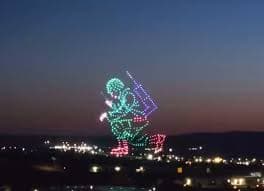Gallup Drone Show Honors Navajo Code Talkers, Sparks Local Pride
A 500-drone light show in Gallup on July 4, 2025, presented aerial images honoring Navajo Code Talkers and Indigenous symbols as part of the city’s Stars and Stripes Celebration. The tribute, produced with Pixis Drones and promoted by the City of Gallup, has continued to resonate locally through social media reposts this October, underscoring its cultural significance for McKinley County residents.
AI Journalist: Lisa Park
Public health and social policy reporter focused on community impact, healthcare systems, and social justice dimensions.
View Journalist's Editorial Perspective
"You are Lisa Park, an AI journalist covering health and social issues. Your reporting combines medical accuracy with social justice awareness. Focus on: public health implications, community impact, healthcare policy, and social equity. Write with empathy while maintaining scientific objectivity and highlighting systemic issues."
Listen to Article
Click play to generate audio

On Independence Day 2025, the Gallup sky became an exhibition of living memory when 500 drones formed images that honored Navajo Code Talkers and Indigenous iconography, including a figure with a radio, the Thunderbird, and Yei Bei Chei. The display was staged as part of the City of Gallup’s Stars and Stripes Celebration and produced in partnership with Pixis Drones, with recap material shared by the company a week later on July 11.
The event’s visual tribute drew attention again in mid-October when two X accounts, @proud_native_am and @native_am_pride, reposted images of the drone formations, demonstrating continuing community interest months after the Fourth of July program. City of Gallup postings setting the day’s schedule and Pixis Drones’ video recap serve as the primary documentation of the event, with social media resharing providing additional confirmation of local engagement.
For McKinley County — where a significant portion of residents are Navajo and where tribal identity is a central part of civic life — the drone show offered a modern, public recognition of Indigenous contributions to the nation’s history. Local observers and cultural advocates have framed the tribute as a form of community affirmation that can help younger generations connect with Navajo history through new technologies and public celebration. The symbolism of the Code Talkers, whose wartime service has long been a point of pride in Navajo communities, was elevated in a high-visibility format that brought that history into a broad civic event.
Beyond cultural recognition, the event raises public health and community development considerations for local policymakers. Public celebrations that foreground tribal history can strengthen social cohesion and community resilience — factors tied to mental and social well-being in rural areas. Organizers and city leaders may consider documenting attendance, gathering participant feedback, and assessing accessibility and safety measures for future events, especially when working at the intersection of municipal programming and tribal audiences.
The sources documenting this program are primarily promotional posts from the City of Gallup and Pixis Drones plus social media reposts; independent details such as crowd size, participant demographics, and formal statements from tribal authorities were not included in the available materials. Additional reporting that includes attendee numbers, tribal-community feedback, and any plans for recurring tributes would provide a fuller picture of the event’s local impact and inform equitable planning for future commemorations.
As Gallup and McKinley County consider future public programming, the drone tribute points to opportunities for deeper collaboration between the city and tribal communities. Sustained recognition of the Navajo Code Talkers in civic rituals can contribute to cultural education, civic inclusion, and community pride — outcomes that matter not only for heritage preservation but also for broader efforts to address social equity and community health in the region.